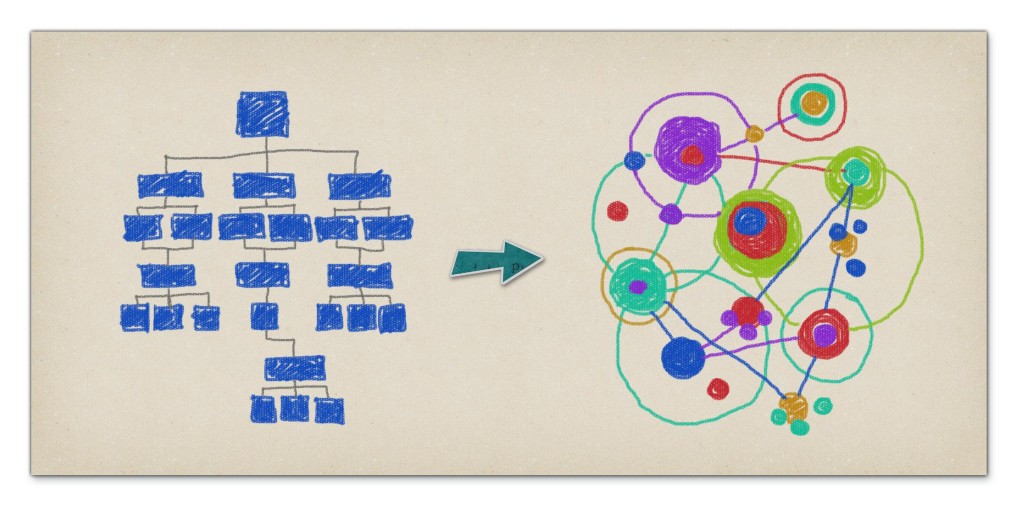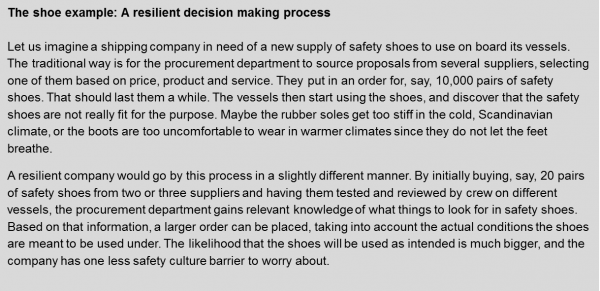Resilience as a business term is buzzing in board rooms all over. But what does it entail? Originally deriving from biology as a term for how plants through evolution have become resilient and managed to sustain growth even in hard conditions, resilience has spread to the business management lingo as a term for new ways of structuring business to match the requirements in the fast paced business arena of our time and age.
In Green-Jakobsen we help clients build (primarily safety-) resilience in shipping companies worldwide. This article is an introduction to the main characteristics of a resilient organisation in Green-Jakobsen’s perspective. It heads up one or more articles specifically on organisational resilience in shipping companies.
Offset for organisational resilience
The offset for organisational resilience is that the world around us is becoming more and more volatile. The pace has picked up over the past decades to an extent where the paradox of constant change has become the reality we have to navigate in. Demands of quarterly growth are continuously harder to meet and tools, approaches and mindsets of yesterday are no longer sufficient. What to do? For companies in the maritime sector as well as in other sectors, this means an increasing demand for the ability to swiftly shift and adapt to new circumstances, stakeholders, markets, etc.
Rita McGrath, Business School Professor at Colombia Business School, argues that companies must develop the ability to rapidly and continuously address new opportunities, rather than search for increasingly unsustainable long-term competitive advantages.
In general, organisational resilience can be described as the company’s positive ability to adapt to the consequence of change, whether this change is initiated by market changes, innovation or even natural disasters.
Characteristics of a resilient company
Traditionally, companies have analysed and planned improvement and development from the board room based on analysis, vision, goals, strengths and opportunities. A strategy is made by management from the inside-out, so to say.
A resilient company, however, has a slightly different perspective: It has a fundamental perception of itself being a field player in a volatile world and in order to succeed, this change readiness has to permeate the entire company. It affects the way systems are organised and it fosters a certain systems-mindset. Companies have to utilise their network and capacity to stay alert and constantly in tune with what is going on on all levels – in markets, business units, surroundings, media, etc. This means that, for instance, change inspiration or innovation does not necessarily start in the board room but can be sourced through the entire company network contact plane. And at the same time, relevant knowledge resources are always looped in in the decision making processes.

Hierarchies and organisational charts are more fluent in the resilient, network based organisation where everything is interlinked. Interaction and processes are no longer linear and top-controlled. Knowledge sharing and -sustaining are ways to make sure that the company has several resistant anchor points and does not necessarily suffer damage should it somehow be amputated.

Organisational accountability – not individual responsibility
Every now and then, we encounter a misconception in the term resilience – it can take on a tang of individual responsibility in a negative sense; the employee’s responsibility to run faster and work harder when the company is suffering hardship. As if human performance needs tweaking rather than organisational performance.
This is not the intention with the Green-Jakobsen usage of the term organisational resilience. We view the whole company system as greater than the sum of its parts. A resilient company can rely on accountable employees in the sense that everyone shares a mindset and strives for a common goal. Knowledge is shared, ideas and innovation is sourced through network, and formal as well as informal mindset role models practise their influence to ensure that this mindset is integrated in everything employees say or do.
Recipe for redesign
So what should we head for? First, we should learn from our past and not disengage with what experience has taught us. At the same time we should prepare to transition to a new paradigm that is less focused on short term results, individual and operational excellence but rather on dynamic, network based business development and organisation. Remember the safety shoe example.
Redesigning for resilience is not a quick fix. We need to look deeper than into board room strategies to succeed. Resilience is more than a strategy and a way of shuffling around boxes in the organisational diagram – it is a mindset and a culture that requires an effort. This is one of the reasons why our client relations in Green-Jakobsen are often planned in long lasting sequences. For serious, long lasting results, we do not just dive in, turn a few nobs and then let go. We help shipping companies by analysing, advising and conducting training programmes involving the entire organisation at all levels. At the same time we establish hooks in the company procedures for the mindset to stick on to.
In our experience, resilience is fostered by:
Deriving from nature, resilience as a term that describes the essence of what kind of adjustments are required in the volatile business landscape. This is echoed in another appropriate nature-related observation; Charles Darwin’s theory about survival of the fittest. According to him, it is not the strongest species that survive, nor the most intelligent, but the ones most able to adapt to change.
Contact us for personal advice
Would you like us to call you?

